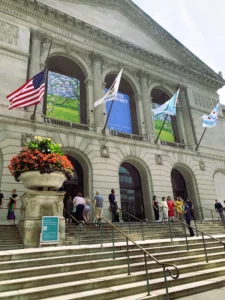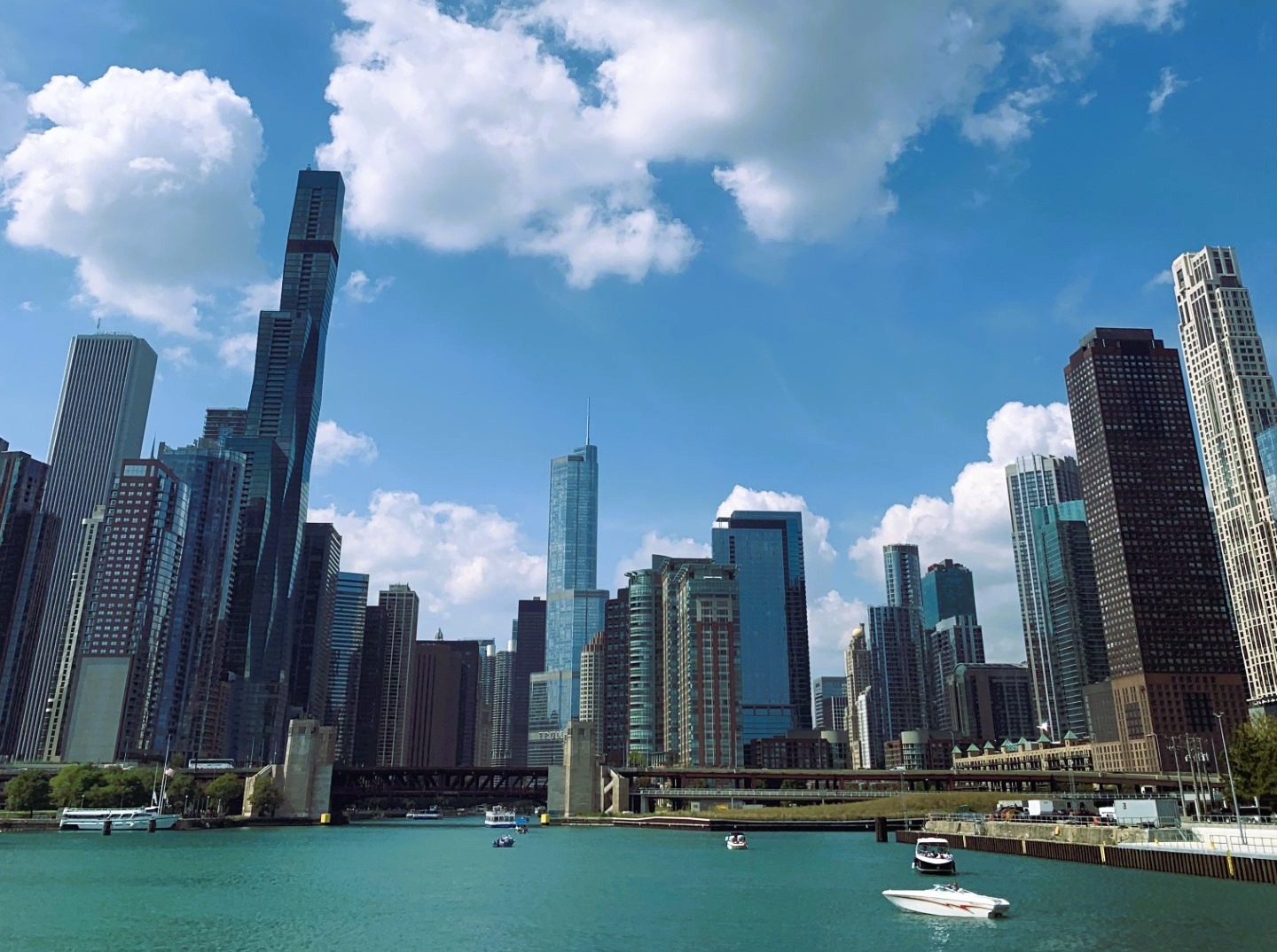When visiting Chicago, let the city’s art be your guide.
“I give you Chicago. It is not London and Harvard. It is not Paris and buttermilk. It is American in every chitling and sparerib. It is alive from snout to tail.” ―H. L. Mencken
And alive it is. Be it with people, music, or sports, Chicago is the living embodiment of American culture and its vivacious energy. But what really makes the city come alive is the creativity of the people and being widely known as the home of artistic achievement- the pinnacle of it even.
You can head to a Cubs game at Wrigley Field or wrestle through crowds to get a selfie with the Cloud Gate (aka The Bean), and while these activities are great, they don’t allow you to truly experience Chicago. To really encounter the Windy City, you need to immerse yourself in its artistic endeavors- especially the architecture, art museum, and food. Focusing on these three aspects will bring forth a true and full portrait of Chicago and will allow you to appreciate its artistic diversity to the fullest.
Chicago’s Architecture Boat Tour
 Ask any Chicagoan, and they will tell you the best way to see the city is from the river. This is because many of the metropolis’s famous buildings are located alongside the Chicago River, and their beauty is best grasped by gently cruising down the river via boat.
Ask any Chicagoan, and they will tell you the best way to see the city is from the river. This is because many of the metropolis’s famous buildings are located alongside the Chicago River, and their beauty is best grasped by gently cruising down the river via boat.
Tour companies have capitalized on this, as evidenced by the many architectural boat cruises offered by vendors. I embarked on a 90-minute journey with a company called Summer of George Tours and Boats.
An hour-and-a-half tour of staring at skyscrapers in a boat? Surely your time as a tourist could be spent better? Well, lucky for you, these are not ugly concrete jungle eyesores. They are engineering spectacles, masters of technological phenomena. These buildings are the culmination of architectural advancements and true imagination.
On the day I took the tour, the cool wind on the upper deck of the boat was a welcome respite from the blistering mid-September heat that the city had been experiencing. Slowly, all the tour passengers and I made our way down the river, staring at soaring towers that all looked surprisingly different from one another. We spent the tour in awe and marveled at the work of our fellow man.
Our funny and informative guide spouted fact after interesting fact. He gave insight on the importance of taking historical events into account when learning about Chicago’s famous skyline. A momentous occurrence was the Great Fire of 1871 which destroyed over three miles of the city and rendered 100,000 people homeless. The destruction of over 17,000 structures meant that significant reconstruction was required. The city was at a place where it needed to rebuild, and thus, talented architects came in droves to restore the city from the ashes. From this, an architectural renaissance was born, with famed innovators doing their best to restore and re-invent the city.
We also learned that the neo-Gothic Tribune Tower has almost 150 stones from world-famous buildings embedded in its structure. This includes little fragments from prominent structures such as the Berlin Wall and the Great Wall of China, to name a few. Such a neat way to pay homage to historic buildings!
On our tour, we gazed at the sunlight gleaming off of giant windows, illuminating the tall giants and creating a shaky mirage on the river below. The famous skyscrapers are kind of the who’s who of the architectural world. Chicagoans and tourists alike can point their fingers anywhere on the skyline, and iconic names like Frank Lloyd Wright, Louis Henry Sullivan, and the famous female architect Jeanne Gang are bound to be associated with the buildings.
Its nickname as the City of Big Shoulders is in reference to many things, but it seems most evident when cruising down the Chicago River and seeing the large, imposing leviathans casting shadows below. Skyscrapers so high, they seemingly rip open clouds to announce their presence. The architectural cruises are also available during the evenings, offering magical views of the illuminated skyline in the moonlight. Be it by day or night, Chicago’s skyline is painted with the behemoths of the Art Deco, Modernism, and Beaux Arts movements. Giant ghosts of an era are forever memorialized in the city itself.
Art Institute of Chicago
 Not many cities can promise getting lost in a sea of Renoir, Basquiat, Degas, and Monet under one roof. But that’s because most cities aren’t Chicago. The city rightfully has bragging rights as the home of the Art Institute of Chicago– a beautiful building that houses equally beautiful artwork.
Not many cities can promise getting lost in a sea of Renoir, Basquiat, Degas, and Monet under one roof. But that’s because most cities aren’t Chicago. The city rightfully has bragging rights as the home of the Art Institute of Chicago– a beautiful building that houses equally beautiful artwork.
Founded in 1879, the Art Institute of Chicago is one of the top tourist destinations in the city. It was built as both a museum and art school in response to rebuilding the city after The Great Fire. Second only to New York’s Metropolitan Museum of Art in terms of size, the Art Institute of Chicago is a must-see attraction that houses over 300,000 works of art and has a very impressive collection that is revered worldwide.
Popular works such as Edward Hopper’s Nighthawks and American Gothic by Grant Wood are just a few of the many notable paintings showcased in the museum. These are not just pieces the most sophisticated of art connoisseurs would recognize- they are heavily featured in popular culture and are recognizable by many as some of the most famous paintings in the world.
Art is important to humanity- after all, man has been creating art for millennia- starting with primitive sketches adorning cave walls. Much like Chicago’s skyline being the very best of architecture- the Art Institute is the very best of traditional art.
More than just paintings, the museum contains exquisite Egyptian tombs and intricate Grecian urns that leave one wonderstruck. Beautiful and moving interactive works such as Félix González-Torres’s Untitled (Portrait of Ross in L.A.) are present. This piece consists of a giant pile of individually wrapped colorful candies that museum-goers are encouraged to take from the stack. The 175-pound work from 1991 is supposed to represent the artist’s lover, Ross, and his ideal body weight when he was, unfortunately, dying of AIDS. The work is deeply moving and has gone viral over the years due to its simple yet poetic nature.
An entire floor boasts famous photographs such as Diane Arbus’s unsettling works and Dorothea Lange’s Depression-era Migrant Mother. The historical importance photography section is awe-inspiring and profoundly moving.
The museum has art spanning many centuries, ideologies, and movements. You’ll find great Renaissance works on one wall and famous post-modern and Impressionist works just a stone’s throw away. The casual nature of seeing such prominent works is startling. The Art Institute of Chicago is a wonderful stop to explore the powerful visionaries of art and admire the beautiful building that houses all these magnificent creations.
World-class food
And finally, the last art form Chicago is revered for is not hung up in a long museum corridor, nor does it adorn the Chicago tower landscape. Rather, it’s the art that ends up on your plate. Food. Eating good food is a Chicagoan’s favorite pastime, other than watching Major League Baseball, of course.
I am not talking about the local dishes of the city, which include the Chicago Hot Dog, Italian Beef Sandwiches, or Deep-dish pizza (although the latter was a major factor in my visiting Chicago). I am instead referring to the fact that Chicago is decorated with over twenty Michelin stars– making it the ultimate foodie city.
The international acclaim that Michelin Stars bring has cemented Chicago as a place with spectacular and world-renowned restaurants. In Chicago, dinner is just not merely dinner. It is theatre. It’s about expression. The best Chicago restaurants’ menus are viewed with the same esteem as the Old Masters’ work in the Art Institute of Chicago or with the same joy as tilting your head to the skies to take in Chicago’s historic skyline. A culmination of centuries of culinary techniques and personal innovation takes the form of the foie gras on your plate.
Chicago chefs are celebrities, they have fans and some even have cult status, like Stephanie Izard of Girl and the Goat. In a city where chefs are rockstars, it’s imperative for them to constantly push the limits of creativity and re-imagine timeless dishes in a new light. The next best dish or technique means survival and notoriety in Chicago’s food world. Having such cutthroat competition between the top restaurants and the pressure to maintain a Michelin star yields much pressure, but it is precisely this pressure that gives birth to the boundlessly creative gastronomy in the city.
 Chicago is a place where people joyfully wait upwards of 3 hours for a cheeseburger at Au Chevals’ or proudly watch an entire Netflix series dedicated to one of the most revered restaurants in town- Alinea– and its chef and his innovative process. It’s a city that cultivates artistic growth. This allows restaurateurs to express themselves through world cuisine. And patrons get to reap the rewards by dining at places like Sepia, where every item in their four-course menu is seemingly the piece de resistance. Cooks are artists and Chicagoans and tourists alike cannot help but marvel at the beautiful art these creatives are capable of concocting.
Chicago is a place where people joyfully wait upwards of 3 hours for a cheeseburger at Au Chevals’ or proudly watch an entire Netflix series dedicated to one of the most revered restaurants in town- Alinea– and its chef and his innovative process. It’s a city that cultivates artistic growth. This allows restaurateurs to express themselves through world cuisine. And patrons get to reap the rewards by dining at places like Sepia, where every item in their four-course menu is seemingly the piece de resistance. Cooks are artists and Chicagoans and tourists alike cannot help but marvel at the beautiful art these creatives are capable of concocting.
Chicago is a city that inspires awe. Its status as an art juggernaut has been cemented in history with its awe-inspiring skyscrapers, some of the world’s most notable art housed in its beautiful museum, and chefs that are consistently pushing culinary boundaries to produce some of the best food on the planet. It is an art city where creativity flourishes and is celebrated as a worthy endeavor. Chicago has rebuilt itself from the ashes and it is the architects, the artists and the chefs that have brought the city back to life. For your next trip to the Second City, take the architecture boat cruise, get tickets to the Art Institute of Chicago and make your reservation at a Michelin hotspot. It is only then you can see how alive the city truly is!

